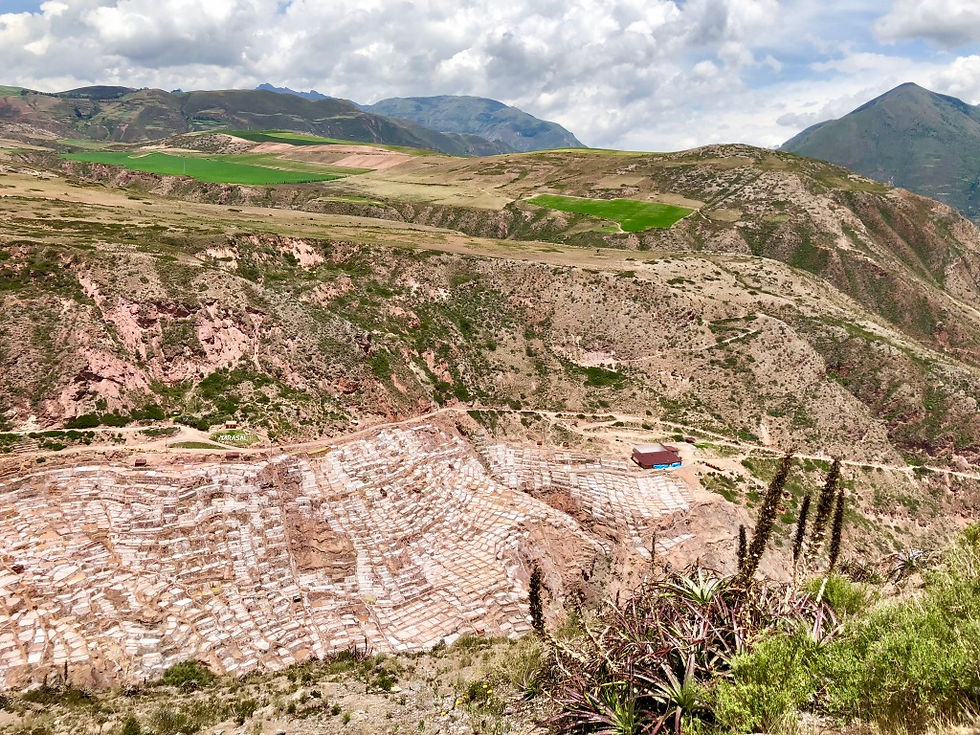Salineras de Maras Tour
- The Bella Blog

- Mar 14, 2019
- 4 min read
The now famous Maras Salt!

If your luggage is at its weight limit DO NOT, I repeat DO NOT go to the Maras Salt Pond and buy 10 lbs of salt!!! Couldn't resist. I got salt for healing and salt for cooking - a smoked salt and salt with chiles.
Also do not pack in your carry on if you are going back to the states. After a very long inquiry which nearly resulted in a missed flight, one member of our group had her salt confiscated by TSA in Houston.

Sometimes things don't go as planned! This was true when we toured Salineras de Maras.
Maras is a town in the Sacred Valley of the Incas, 40 kilometers north of Cusco in the Cusco Valley Region of Peru. The town is well known for its salt evaporation ponds, located towards Urubamba from the town center, which have been in use since Inca times. The salt-evaporation ponds are four kilometers north of the town, down a canyon that descends to the Rio Vilcanota and the Sacred Valley of the Incas. -- The Incas (early 13th century to 1572) are credited with many of Peru’s striking constructions, but these ponds were created during the Chanapata Culture (AD200 to AD900).
The Maras area is accessible by a paved road, which leads from the main road leading through the Sacred Valley between Cusco and the surrounding towns.

Since pre-Inca times, salt has been obtained in Maras by evaporating salty water from a local subterranean stream. The highly salty water emerges at a spring, a natural outlet of the underground stream. The flow is directed into an intricate system of tiny channels constructed so that the water runs gradually down onto the several hundred ancient terraced ponds. Almost all the ponds are less than four meters square in area, and none exceeds thirty centimeters in depth. All are necessarily shaped into polygons with the flow of water carefully controlled and monitored by the workers. The altitude of the ponds slowly decreases, so that the water may flow through the myriad branches of the water-supply channels and be introduced slowly through a notch in one sidewall of each pond.
The proper maintenance of the adjacent feeder channel, the side walls and the water-entry notch, the pond's bottom surface, the quantity of water, and the removal of accumulated salt deposits requires close cooperation among the community of users. It is agreed among local residents and pond workers that the cooperative system was established during the time of the Incas, if not earlier. As water evaporates from the sun-warmed ponds, the water becomes supersaturated and salt precipitates as various size crystals onto the inner surfaces of a pond's earthen walls and on the pond's earthen floor. The pond's keeper then closes the water-feeder notch and allows the pond to go dry. Within a few days the keeper carefully scrapes the dry salt from the sides and bottom, puts it into a suitable vessel, reopens the water-supply notch, and carries away the salt. Color of the salt varies from white to a light reddish or brownish tan, depending on the skill of an individual worker.
Some salt is sold at a gift store nearby.
The salt mines traditionally have been available to any person wishing to harvest salt. The owners of the salt ponds must be members of the community, and families that are new to the community wishing to propitiate a salt pond get the one farthest from the community. The size of the salt pond assigned to a family depends on the family's size. Usually there are many unused salt pools available to be farmed. Any prospective salt farmer need only locate an empty currently unmaintained pond, consult with the local informal cooperative, learn how to keep a pond properly within the accepted communal system, and start working.

The movement of tectonic plates pushed the seabed up to form the Andes. The sea salt was locked into the rocks and filters out through the Qoripujio spring.
The mineral-rich salt doesn’t just add flavor to dishes, it’s also good for you. It contains magnesium, iron, calcium and zinc, which help reduce stress and prevent anaemia and osteoporosis.
It provides a buffer for blood sugar levels, preventing diabetes and enabling diabetics to use less insulin. What’s more, the producers of the gourmet salt say its source goes through an area lined with rose quartz, giving it additional healing benefits
The area is not widely industrialized, and the salt is still just bagged up, packaged, and sold at market. Today there are about 3,000 pools that are still harvested by the community of local families who control the salt pans, the transport roads to the valley, and generally the entire salt production from the site, which remains much the same as as it was when the Inca discovered it over 1,000 years ago.
BTW - The admission fees go directly to the co-operative of families that work the salt mines and that money is having a positive impact
And... Amazon now sells their salt - you can buy an 8oz bag for almost 10 times more than the sellers in Maras charge.
Check us out below - Great Tour❤️



Comments